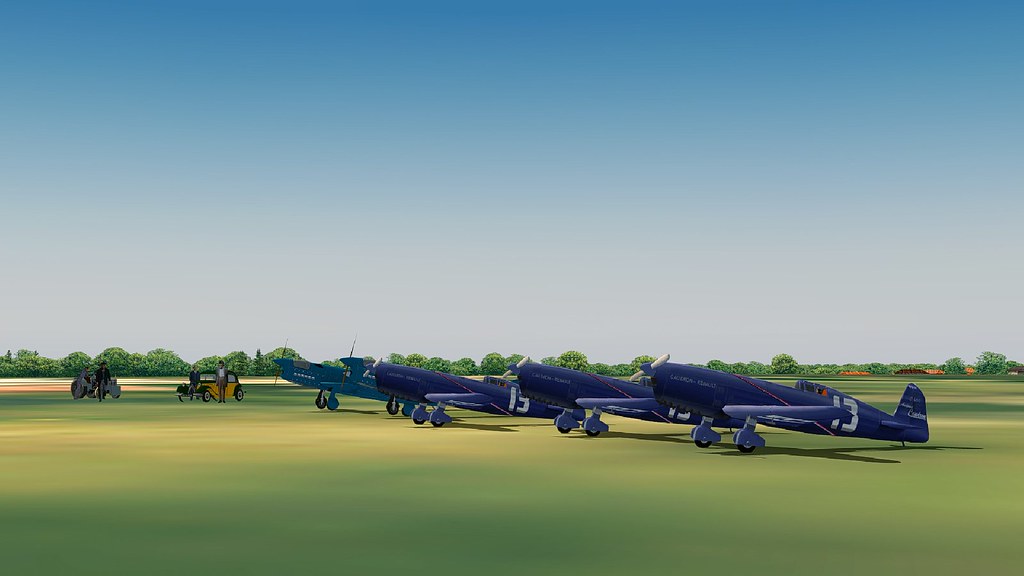A repaint with a story. Recently I did spend a short holiday in the extreme south of the Netherlands. I stayed an a small town called Mechelen with is located roughly between the Dutch city Maastricht and the German town of Aachen. You can find many reasonably short steep climbs over there which are the first signs of the Ardennes which are a bit more south. I'm a cyclist and I love to climbs these steeps hills by bike. It empties the mind and the only concern I have, is how to reach the top. At the end of the town I stayed, where you cross the small river called the "Geul", there is a small monument near bunker, which reminds to 3 events. The first one is the Dutch defence against the German invasion. The second and third events are air crashes during the war. The first is about a Halifax which crashed there after a bomb raid over Cologne in February 1943. The second one is about a P-47D which crashed there on the 26th of December 1944.
The (translated Dutch) text about the last event reads as follows: "During the Battle of the Bulge around Christmas 1944, lieutenant Clinton Winters was ordered to attack the German troops. His Thunderbolt, a single engine fighter, was hit by German anti-aircraft fire on its way to Houffalize (Note Huub: A small Belgian village just north of Bastogne) and caught fire. Eye witnesses saw the burning aircraft flying over the farmhouse called "de Pley" (Note Huub: currently a hotel) and crashing in the "Kruisbos" woods behind the farmhouse. The body of the lieutenant was found in the meadows behind the farmhouse with the parachute still unopened. Lieutenant Clinton Winters jr (23) is buried at the Netherlands American Cemetery and Memorial in Margraten."
I have climbed the hill called Schweiberg on my bicycle, many times and you have a great view over the meadows and forest mentioned in the text. It is very green beautiful and very peaceful area and you can hardly imagine that it hasn't always been like this. When I came home I decided to some research and try to find out what the plane looked like. Googling on the name an rank gave the aircraft number and the aircraft number gave the details of the mission. In the combat history of 404 Fighter group the mission is described as follows: "Ground haze up to 400 feet spoiled an otherwise weather-perfect day Tuesday, December 26, but Col. Moon, after a test hop, decided the planes could fly through the haze easily. Captain Ollie O. Simpson's 15-plane 506th formation knocked out a gun position and six trucks and damaged an armoured vehicle in the Dreiborn area east of Monschau, and Captain Ray's 507th squadron of 16 worked with the 78th Infantry Division west of Schmidt, dumping their bombs on a reported concentration of enemy tanks which were marked by 78th guns with red smoke shells. The 506th lost First Lieutenant Robert G. Fenstermacher and First Lieutenant Clinton Winters when their planes were hit by flak."
The aircraft was also easy to trace as the aircraft had been the personal mount of the commander of 506th FS, 404th FG, Harold G (Hal) Shook. However after flying 105 combat missions, he was rotated home during the first week of October 1944. Obviously the aircraft was given to another pilot and was flown on the 26th of December by Lieutenant Clinton Winters. When the unit was still active in France earlier in 1944 there were several pictures made from both sides. But what the aircraft exactly looked like on the 26 of December is not known. There is a picture showing Clinton Winters in front of a P-47, however it is not clear whether he is in front the the aircraft he flew and the picture doesn't show much details.
The area is under the main routes the bomber took on their way to the Ruhr area and as the war more or less came to a temporarily halt here during the autumn of 1944, Clinton Winters is not the only one who lost his life in this region.
The repaint is based on John "Bomber_12th" Terrell's incredible paintkit.









 ,
,









